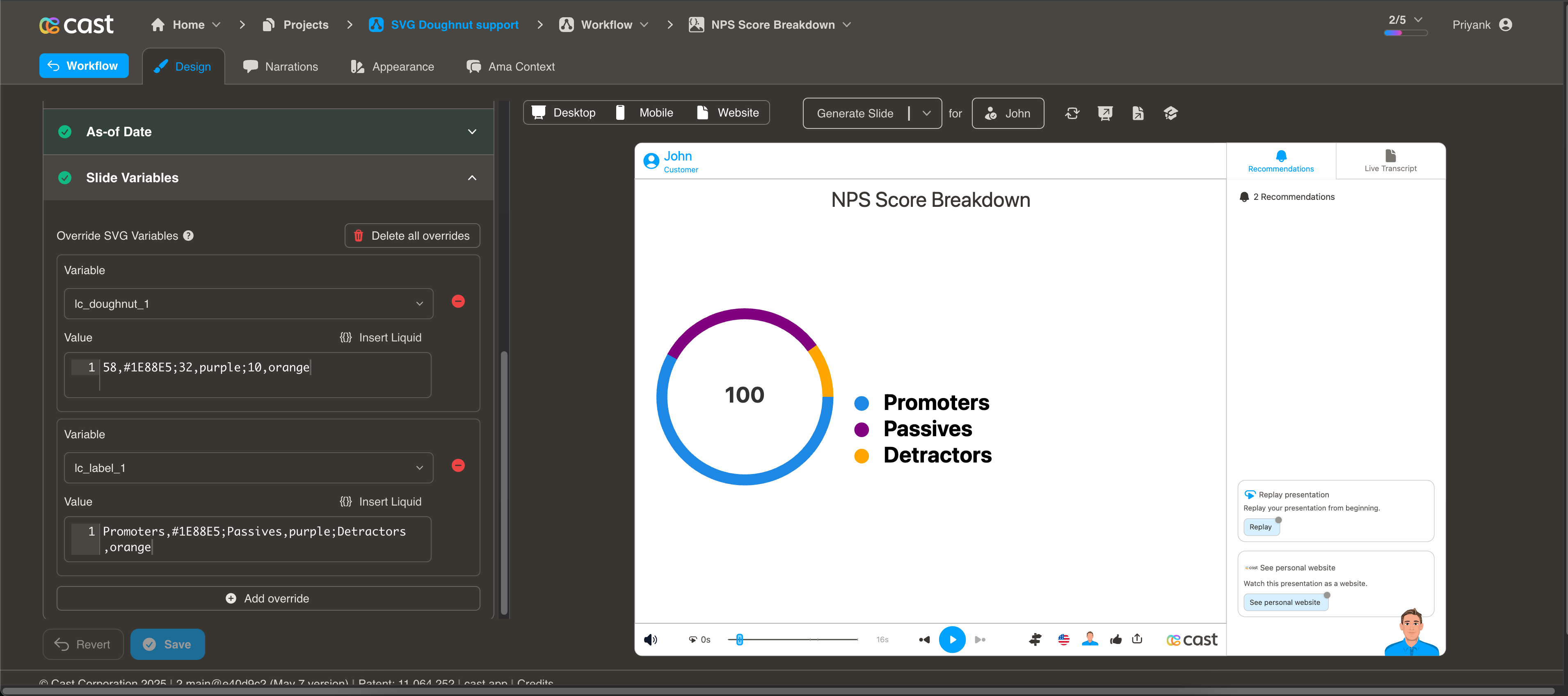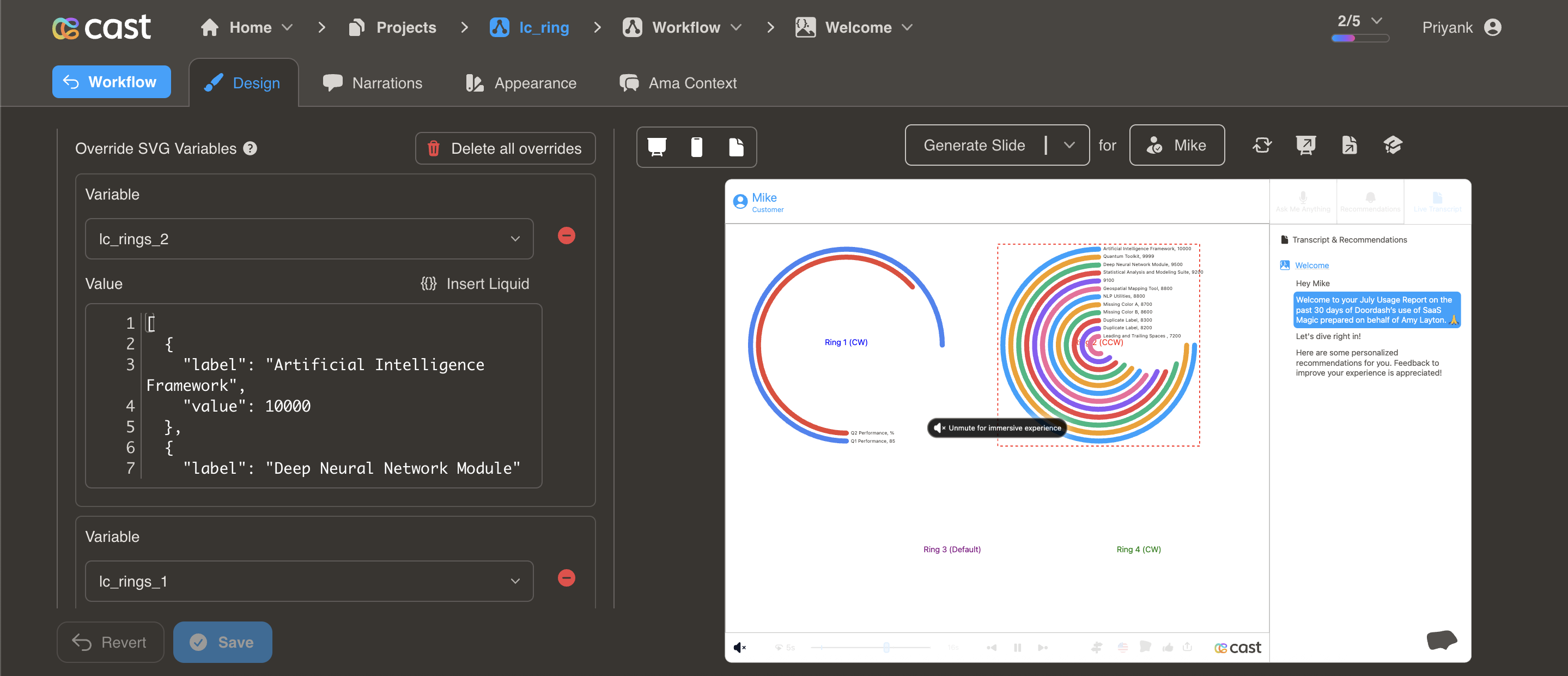Distribution & Proportions
Visualize proportional data, market share, survey results, and category distributions using donut charts, ring charts, and labels.
When to Use These
Perfect for:
- Market share and competitive analysis
- Survey results and response distributions
- Budget allocation across categories
- Customer segmentation data
- NPS scores and satisfaction ratings
- Resource distribution
- Category breakdowns and proportions
Donut Charts
lc_doughnut_*
Display segmented data in a circular donut chart format. The chart always displays as a complete circle with values proportionally adjusted to fill the entire circumference.
Element Setup
Main Element:
- Element type:
<circle> - ID format:
lc_doughnut_*(e.g.,lc_doughnut_nps,lc_doughnut_market-share)
Companion Element:
- Use
lc_label_*for legends and segment labels (see Labels section below)
Input Format
Basic Format - Values Only:
"58;32;10"
Creates three segments:
- Segment 1: 58%
- Segment 2: 32%
- Segment 3: 10%
With Color Specification:
"58,#1E88E5;32,purple;10,orange"
Creates three colored segments:
- Segment 1: 58% with hex color #1E88E5 (blue)
- Segment 2: 32% with named color “purple”
- Segment 3: 10% with named color “orange”
Color Options
CSS Color Names:
"45,red;30,blue;25,green"
Hexadecimal Values:
"45,#FF0000;30,#0000FF;25,#00FF00"
Mixed Formats:
"45,#1E88E5;30,purple;25,orange"
Default Colors: If no colors are specified, the system uses your project’s default color palette.
Value Processing
- Minimum value: 1 (segments require at least 1 to be visible)
- Zero values: Converted to 1
- Negative values: Treated as 1
- Proportional: Values are automatically scaled to fill 100% of the circle
- Start position: Segments begin at 12 o’clock and progress clockwise
Usage Example
<!-- In your SVG -->
<circle id="lc_doughnut_nps" cx="200" cy="200" r="100" />
<text id="lc_label_nps-legend">Promoters;Passives;Detractors</text>
<!-- In your dataset -->
{{ nps }} = "58,green;32,yellow;10,red"
{{ nps-legend }} = "Promoters,green;Passives,yellow;Detractors,red"
Result: Three-segment donut showing NPS distribution with colored legend
Common Use Cases
NPS Scores:
"58,#4CAF50;32,#FFC107;10,#F44336"
Labels: "Promoters,#4CAF50;Passives,#FFC107;Detractors,#F44336"
Market Share:
"45,blue;30,purple;15,orange;10,gray"
Labels: "Product A,blue;Product B,purple;Product C,orange;Others,gray"
Budget Allocation:
"40,#2196F3;30,#4CAF50;20,#FF9800;10,#9C27B0"
Labels: "Engineering,#2196F3;Marketing,#4CAF50;Sales,#FF9800;Operations,#9C27B0"
Ring Charts
lc_rings_*
Display hierarchical or comparative data in concentric ring format. Ideal for showing multiple data points with emphasis on top performers through ring positioning.
Element Setup
Main Element:
- Element type:
<rect> - ID format:
lc_rings_*(e.g.,lc_rings_performance,lc_rings_comparison)
Input Format
JSON Array of Objects:
[
{
"value": 85,
"label": "Artificial Intelligence Framework",
"color": "#4285F4"
},
{
"value": 72,
"label": "Deep Neural Network Module",
"color": "#EA4335"
},
{
"value": 58,
"label": "Machine Learning Pipeline",
"color": "#FBBC04"
}
]
Required Properties
value: Numeric value for ring sizing- Negative values automatically converted to 0
- Higher values get outermost rings
label: Text description for the ring- Displayed at the start of each ring
- Automatically formatted with value
Optional Properties
color: Color specification- Hex codes:
"#4285F4" - CSS names:
"royalblue" - RGB values:
"rgb(66, 133, 244)" - If omitted, uses project’s color palette
- Hex codes:
Automatic Features
- Auto-sorting: Rings automatically sort by value (highest = outermost)
- Maximum rings: Displays up to 12 rings (additional data truncated)
- Auto-sizing: Ring thickness and spacing calculated automatically
- Label positioning: Labels placed at ring start with formatted values
Usage Example
<!-- In your SVG -->
<rect id="lc_rings_products" width="400" height="400" />
<!-- In your dataset (as JSON string) -->
{{ products }} = '[
{"value": 85, "label": "Product A", "color": "#4285F4"},
{"value": 72, "label": "Product B", "color": "#EA4335"},
{"value": 58, "label": "Product C", "color": "#FBBC04"}
]'
Result: Three concentric rings with Product A (85) as outermost ring
Common Use Cases
Performance Comparison:
[
{ "value": 92, "label": "Q4 Revenue", "color": "green" },
{ "value": 85, "label": "Q3 Revenue", "color": "blue" },
{ "value": 78, "label": "Q2 Revenue", "color": "purple" }
]
Competitive Analysis:
[
{ "value": 45, "label": "Our Company", "color": "#2196F3" },
{ "value": 30, "label": "Competitor A", "color": "#FF5722" },
{ "value": 15, "label": "Competitor B", "color": "#FFC107" }
]
Hierarchical Data:
[
{ "value": 100, "label": "Total Market", "color": "#9C27B0" },
{ "value": 65, "label": "Our Segment", "color": "#4CAF50" },
{ "value": 25, "label": "Our Share", "color": "#2196F3" }
]
Labels and Legends
lc_label_*
Create labeled lists with optional colored bullets. While commonly used with donut charts, labels operate independently and work with any visualization.
Element Setup
Main Element:
- Element type:
<text> - ID format:
lc_label_*(e.g.,lc_label_legend,lc_label_categories)
Input Format
Basic Format - Labels Only:
"Label1;Label2;Label3"
Creates three labels without color bullets.
With Color Bullets:
"Label1,color1;Label2,color2;Label3,color3"
Adds colored circular bullets before each label.
With Word Wrapping:
"Long Label Text,blue,20;Another Long Label,red,20"
Third parameter sets character limit for word wrapping.
Color Options
Named Colors:
"Promoters,blue;Passives,purple;Detractors,orange"
Hex Values:
"Promoters,#1E88E5;Passives,#9C27B0;Detractors,#FF9800"
Default Colors: If colors are omitted, uses project’s default color palette:
"Category A;Category B;Category C"
Bullet Behavior
- Auto-sizing: Bullet size scales with font size
- Positioning: Placed to the left of label text
- Spacing: Automatically calculated for clean alignment
- Optional: Only appears when colors are specified
Usage Example
<!-- In your SVG -->
<text id="lc_label_nps-scores" x="50" y="100" font-size="16">
Placeholder text
</text>
<!-- In your dataset -->
{{ nps-scores }} = "Promoters (9-10),#4CAF50;Passives (7-8),#FFC107;Detractors (0-6),#F44336"
Result: Three labeled items with colored bullets matching colors
Word Wrapping
With Character Limit:
"This is a very long product description that needs wrapping,blue,30"
- Text wraps after 30 characters per line
- Preserves word boundaries
- Maintains bullet alignment
Multiple Wrapped Labels:
"Long Category Name One,blue,25;Long Category Name Two,green,25;Long Category Name Three,red,25"
Common Use Cases
Donut Chart Legend:
"Promoters (58%),green;Passives (32%),yellow;Detractors (10%),red"
Status Indicators:
"Completed,#4CAF50;In Progress,#2196F3;Not Started,#9E9E9E"
Product Categories:
"Enterprise Plan,#1E88E5;Professional Plan,#7B1FA2;Starter Plan,#F57C00"
Survey Responses:
"Strongly Agree,#4CAF50;Agree,#8BC34A;Neutral,#FFC107;Disagree,#FF5722;Strongly Disagree,#F44336"
Best Practices
Choosing the Right Chart
| Use This | When You Need To |
|---|---|
| Donut | Show percentage distribution, compare parts to whole |
| Rings | Show hierarchical data, emphasize top performers, compare metrics |
| Labels | Add legends, create status lists, label any chart |
Design Tips
- Limit segments - Keep donut charts to 3-7 segments for clarity
- Sort meaningfully - Order segments by size or importance
- Use color wisely - Choose colors that convey meaning (red=negative, green=positive)
- Add labels - Always include
lc_label_*with donut charts - Match colors - Ensure label colors match chart segment colors
- Include values - Show percentages or numbers in labels
Color Strategy
Status Colors:
- ✅ Green: Positive, success, promoters
- ⚠️ Yellow/Orange: Warning, neutral, passives
- ❌ Red: Negative, error, detractors
- 🔵 Blue: Neutral, information
- ⚫ Gray: Inactive, unknown, other
Brand Colors:
- Use your company’s color palette
- Maintain consistency across slides
- Ensure sufficient contrast
Complete Example
NPS Score Visualization
<!-- In your SVG -->
<circle id="lc_doughnut_nps" cx="300" cy="200" r="120" />
<text id="lc_label_nps-legend" x="450" y="150" font-size="18">
Placeholder
</text>
<!-- In your dataset -->
{{ nps }} = "58,#4CAF50;32,#FFC107;10,#F44336"
{{ nps-legend }} = "Promoters (58%),#4CAF50;Passives (32%),#FFC107;Detractors (10%),#F44336"
Result:
- Donut chart with three segments (green, yellow, red)
- Matching legend with colored bullets and percentages
- Clear visual indication of NPS distribution
Troubleshooting
| Issue | Solution |
|---|---|
| Donut not showing | Verify element is <circle> with correct ID prefix |
| Rings not displaying | Check element is <rect> and JSON is valid |
| Labels missing bullets | Add color specification: "Label,color" |
| Colors not matching | Ensure exact color values match between chart and labels |
| Segments too many | Limit to 5-7 segments for readability |
| Ring labels cut off | Increase rect dimensions to provide more space |
| Values don’t add to 100% | Values are automatically scaled - this is normal |
Related Features
- Progress Metrics - Bar and column charts
- Dynamic Colors - Change colors conditionally
- Quick Reference - Syntax cheat sheet

